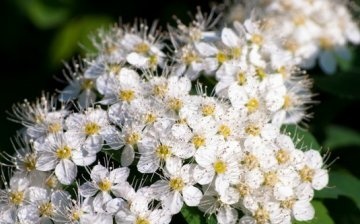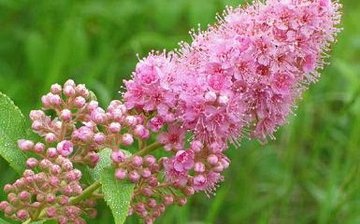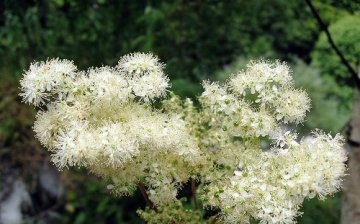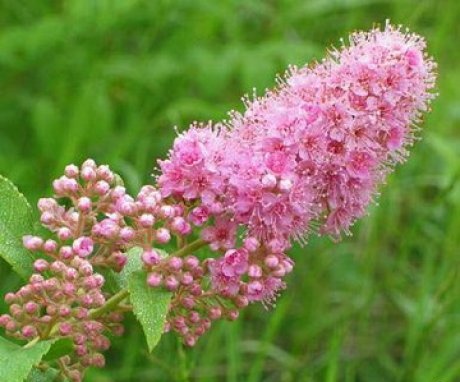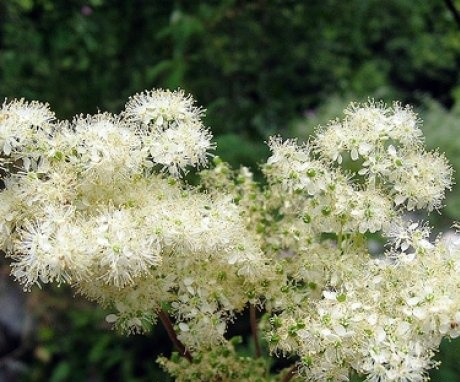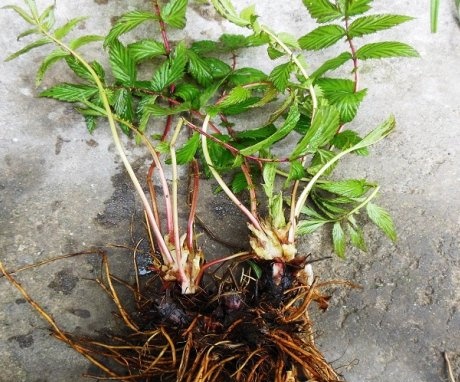Types of meadowsweet medicinal, its cultivation and rules of care
Meadowsweet is a perennial plant that belongs to the Rosaceae family. Various species, and there are about 17 of them, grow in different regions of the Northern Hemisphere. Also recently, many new varieties and hybrids of this plant have been bred.
Content:
- Types of meadowsweet
- Caring for meadowsweet
- Reproduction of meadowsweet medicinal
- Healing properties
Types of meadowsweet
Elm-leaved meadowsweet:
- You can meet the meadowsweet near marshes, in the floodplains of rivers and in swampy meadows.
- This is perennial, which can reach a height of 1.5 meters.
- Its stem is ribbed, naked, herbaceous.
- The flowers are small, collected in inflorescences in the form of a large panicle. Their shade is yellow-white and when blooming, a honey aroma appears.
- The flowering period begins in mid-June and can last 3-4 weeks.
- Refers to medicinal types.
Six-petaled meadowsweet:
- This type of meadowsweet can be found in dry steppes, in fields and forest glades in Europe, the Caucasus and Siberia.
- The stems can reach a height of 80 cm. The root of this species is oblique, small in size.
- Small, thin roots depart from it, in which oval thickenings form in the middle. The so-called ground nuts.
- Six-petalled meadowsweet is a medicinal plant.
Kamchatka meadowsweet:
- You can meet this type of meadowsweet on the Kamchatka Peninsula, where the name comes from, on the Kuril Islands and on Sakhalin Island.
- Kamchatka meadowsweet is one of the tallest species, the stem length can reach 3 meters.
- Large inflorescences are white or creamy. It mainly grows where there is sufficient moisture.
- This is a medicinal meadowsweet.
Palm-shaped meadowsweet:
- This species is found in meadows near forests in the territories of the Far East. His leaves are large, in appearance resembling spread fingers of the palm, which is why he received such a name. The height of the stem reaches only 1 meter, so the plant does not stand out much in the meadow thickets. But the rhizome of the meadowsweet differs from other species. It is large, straight and grows well underground. Refers to medicinal plants.
Willow meadowsweet:
- This type of meadowsweet resembles a shrub in appearance.
- Stems are large, brownish.
- The leaves are sharp, elliptical and have pointed edges.
- Flowers are collected in large panicles and are white in color. The flowering period is early and mid-summer.
- Unpretentious in care, tolerates winter well.
- Refers to both medicinal and decorative species.
Red meadowsweet:
- This species is native to North America.
- In height, branches of red meadowsweet can reach 2.5 meters.
- The flowers are large, collected in large panicles and painted in red or red-pink shades.
- The flowering period for this species begins in mid to late summer and lasts about 3 weeks.
- This type of meadowsweet prefers light and humid growing areas. It tolerates frosty winters well.
- It is mainly used as an ornamental plant.
Caring for meadowsweet
Initially meadowsweet is a wild plant. But for some time now it has been cultivated at home. They are planted in dachas, in gardens, near artificial lakes and in parks. New varieties are being developed with denser inflorescences and different colors. In care, they are, as well as unpretentious wild-growing ones. They prefer plenty of moisture and light.
Many varieties are frost-resistant and do not require additional shelter for the winter.
Despite the fact that meadowsweet is usually a large and lush bush with a large number of panicles-inflorescences that adorn it with their density, it does not require special attention and special care.
Care secrets:
- For planting and further growth of the plant, you must choose a place with good lighting.
- Watering should be moderate, but the soil should not dry out too much, and water stagnation should also be avoided. That is, the soil in which meadowsweet grows should be not only fertile, but also well-drained.
- It is also necessary to loosen the soil around the bush.
Basically, all types of meadowsweet are frost-resistant, but there are several tender decorative varietiesthat should be covered for the winter. It is also necessary to insulate young bushes and seedlings.
Reproduction of meadowsweet medicinal
Reproduction of meadowsweet occurs with using cuttings and root layers. The first type of reproduction is used mainly for ornamental varieties; in the second way, decorative and medicinal, wild species reproduce.
Propagation by cuttings is a simple way, and the rooting percentage reaches 70% without the use of additional rooting agents.
Propagation by cuttings:
- The process of cuttings is carried out in early and mid-autumn, if desired or necessary, this event can be carried out in the summer, however, due to the high ambient temperature, the percentage of rooting may be lower than usual.
- Cuttings are cut from strong branches. Each should have 4–5 leaves, of which the lower one is removed, and the rest are shortened in half. Further, the cuttings must be soaked in water for 2-3 hours.
- The substrate for planting is prepared from peat and sand in a ratio of 1 to 1. After soaking, the prepared branches are planted in the substrate at an angle of 45 degrees. Further, the cuttings must be watered and sprayed regularly.
Propagation by root layers can be carried out in the fall.
To do this, a rhizome is dug out and divided into parts so that there are shoots on each piece. Next, they must be placed in a container with wet sand and left in a dark, cool place for the winter. In spring, the rhizomes are planted in a permanent place in pits, the depth of which is no more than 5 cm.
Healing properties
Meadowsweet is rich in tannins, it also contains a large amount of vitamin C, salicylic acid, essential oils and many other useful substances.
Helps with headaches, rheumatism, lowers blood pressure.
It is a hemostatic, analgesic, diuretic. And these are just a few of the medical features of this plant, of which there are a great many.
Medicinal meadowsweet has been used in folk medicine for a long time.
She also found wide application in scientific medicine. Many products are made on its basis. Decorative varieties are widely used in landscape design, to decorate parks and gardens. Artificial ponds and lakes are often decorated with meadowsweet bushes.
More information can be found in the video.



